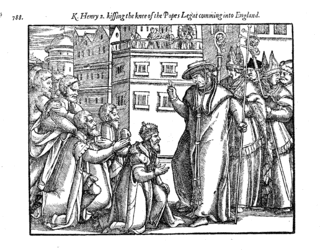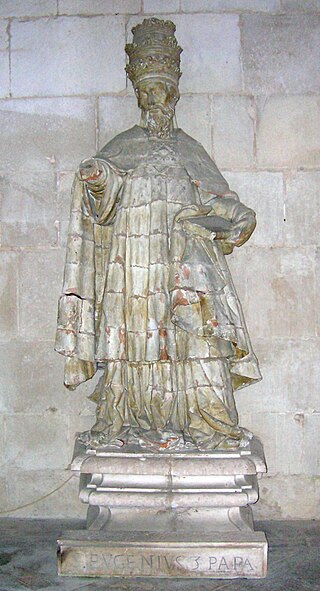A papal judge delegate was a type of judicial appointment created during the 12th century by the medieval papacy where the pope would designate a local judge, often an ecclesiastic, to decide a case that had been appealed to the papal court. [1]
 |
| Part of a series on the |
| Canon law of the Catholic Church |
|---|
| |
A papal judge delegate was a type of judicial appointment created during the 12th century by the medieval papacy where the pope would designate a local judge, often an ecclesiastic, to decide a case that had been appealed to the papal court. [1]
The system began during the pontificate of Paschal II (1099–1118), when the first records appear of the papacy delegating some of its judicial authority to others for the resolution of cases. At first, it was used in order to expedite the discovery of local knowledge of cases, rather than to reduce the papal court's workload. Examples of this early stage include a case from Wales, during the pontificate of Innocent II. This was a dispute between Bernard, the bishop of St Davids, and Urban, the bishop of Llandaff, and was apparently delegated to acquire local knowledge of the dispute. It is only later, during the pontificate of Alexander III that the papal courts appears to have recognized that the delegation system could also reduce the volume of cases that had to be decided at Rome. [2] [3]
An important factor in the growth of the papal judges-delegate system was the corresponding growth of the papal judicial system during the 12th century. [4] Often, cases referred to a judge-delegate were those that were particularly complex, and where the local knowledge of the appointee would be helpful. The appointment ended with the resolution of the case he had been appointed to decide. [1]
The numbers of judges-delegate increased greatly during the 1160s and 1170s. English records for this time are particularly abundant, with a number of English bishops – including Gilbert Foliot, Bartholomew Iscanus, Roger of Worcester – serving over 60 times as judge-delegate for the papacy. [1] Conflicts often arose between papal legates and judges-delegate, and Celestine III ruled that a papal legate could not change the decision of a judge-delegate but was allowed to confirm or implement the decision. Celestine did indicate that the legate was higher in rank than the judge, although he was sovereign in matters relating to his appointed case. [1] Alexander III's decrees on the judicial delegation system form the basis for the description of the system in Gregory IX's Decretales which were published in 1234. Of the 43 items dealing with papal judges-delegate in the Decretales, 18 are Alexander's and a further 15 are from Innocent III. [3]
Papal documents referred to the delegates as iudices delegati. [1] A further development was the grant of exemptions from appointment as judge-delegate, with such exemptions first appearing around 1140. By the end of the 12th century, such exemptions were sought after by local ecclesiastics. [3]

Pope Honorius II, born Lamberto Scannabecchi, was head of the Catholic Church and ruler of the Papal States from 21 December 1124 to his death in 1130.

Pope Celestine III, was the head of the Catholic Church and ruler of the Papal States from 30 March or 10 April 1191 to his death in 1198. He had a tense relationship with several monarchs, including Emperor Henry VI, King Tancred of Sicily, and King Alfonso IX of León.

Pope Victor III, was the head of the Catholic Church and ruler of the Papal States from 24 May 1086 to his death. He was the successor of Pope Gregory VII, yet his pontificate is far less notable than his time as Desiderius, the great abbot of Monte Cassino.

Pope Innocent III, born Lotario dei Conti di Segni, was the head of the Catholic Church and ruler of the Papal States from 8 January 1198 until his death on 16 July 1216.
Theobald of Bec was a Norman archbishop of Canterbury from 1139 to 1161. His exact birth date is unknown. Some time in the late 11th or early 12th century Theobald became a monk at the Abbey of Bec, rising to the position of abbot in 1137. King Stephen of England chose him to be Archbishop of Canterbury in 1138. Canterbury's claim to primacy over the Welsh ecclesiastics was resolved during Theobald's term of office when Pope Eugene III decided in 1148 in Canterbury's favour. Theobald faced challenges to his authority from a subordinate bishop, Henry of Blois, Bishop of Winchester and King Stephen's younger brother, and his relationship with King Stephen was turbulent. On one occasion Stephen forbade him from attending a papal council, but Theobald defied the king, which resulted in the confiscation of his property and temporary exile. Theobald's relations with his cathedral clergy and the monastic houses in his archdiocese were also difficult.

A papal legate or apostolic legate is a personal representative of the Pope to foreign nations, to some other part of the Catholic Church, or representatives of the state or monarchy. He is empowered on matters of Catholic faith and for the settlement of ecclesiastical matters.
Decretals are letters of a pope that formulate decisions in ecclesiastical law of the Catholic Church.
The Treaty of Benevento or Concordat of Benevento was an important treaty between the papacy of Adrian IV and the Norman Kingdom of Sicily. After years of turbulent relations, the popes finally settled down to a peace with the Hauteville kings.
Gerardo Allucingoli was an Italian cardinal and cardinal-nephew of Pope Lucius III, who elevated him in 1182.

Hilary was a medieval bishop of Chichester in England. English by birth, he studied canon law and worked in Rome as a papal clerk. During his time there, he became acquainted with a number of ecclesiastics, including the future Pope Adrian IV, and the writer John of Salisbury. In England, he served as a clerk for Henry of Blois, who was the bishop of Winchester and brother of King Stephen of England. After Hilary's unsuccessful nomination to become Archbishop of York, Pope Eugene III compensated him by promoting him to the bishopric of Chichester in 1147.

The 1198 papal election was convoked after the death of Pope Celestine III; it ended with the election of Cardinal Lotario dei Conti di Segni, who took the name Innocent III. In this election for the first time the new pope was elected per scrutinium.

In 1148, a Council of Reims was called by Pope Eugene III to consider a variety of issues for the Church. Originally the summons to the council went out in October 1147 and it was supposed to be held in February 1148 at Trier, but conditions there were such that it was moved to Reims. A number of the bishops and other Churchmen who had been convoked did not attend and Eugene suspended many of the non-attendees, excepting the other Churchmen of Italy, who were excused. The council convened on 21 March 1148 and is said to have lasted 11 days in total, which would give an end date of 1 April 1148. However, it is possible that it was shorter, given that the large increase in the population of Reims would have strained the town's resources.

The papal election held from 4 to 7 September 1159 following the death of Pope Adrian IV resulted in the election of two rival popes. A majority of the cardinals elected Cardinal Rolando of Siena as Pope Alexander III, but a minority refused to recognize him and elected their own candidate, Ottaviano de Monticelli, who took the name Victor IV, creating a schism that lasted until 1178.

The 1154 papal election followed the death of Pope Anastasius IV and resulted in the election of Pope Adrian IV, the only Englishman to become pope.

The 1143 papal election followed the death of Pope Innocent II and resulted in the election of Pope Celestine II.
The 1144 papal election followed the death of Pope Celestine II and resulted in the election of Pope Lucius II.

The Becket controversy or Becket dispute was the quarrel between Archbishop of Canterbury Thomas Becket and King Henry II of England from 1163 to 1170. The controversy culminated with Becket's murder in 1170, and was followed by Becket's canonization in 1173 and Henry's public penance at Canterbury in July 1174.
A legatine council or legatine synod is an ecclesiastical council or synod that is presided over by a papal legate.

The Tuscan League, also known as the League of San Genesio, was formed on 11 November 1197 at Borgo San Genesio by the chief cities, barons and bishops of the March of Tuscany shortly after the death of Henry VI, Holy Roman Emperor on 27 September 1197.

Pietro Diani was an Italian cardinal. The name "Diana" is incorrect; he signs himself Petrus Dianus.